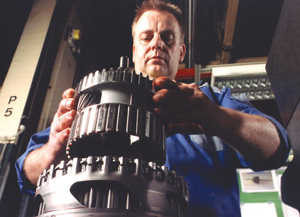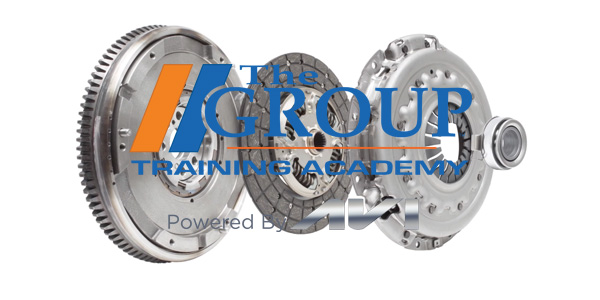Automatic transmissions and transaxles fall into two categories: mechanical and electronic. Older vehicles with mechanical automatics use engine speed, throttle cables, governors and valves to shift gears. Newer vehicles with electronic transmissions use engine rpm and sensor inputs to operate solenoids that route internal fluid pressure to shift gears.
 Inputs include throttle position, engine load (vacuum), vehicle speed and other sensor data that are fed to the transmission control module (TCM) and/or powertrain control module (PCM). The transmission module may be located on the transmission, elsewhere in the engine compartment or combined with the PCM. The transmission control module may also communicate with the ABS/traction control system and modify its operation as needed.
Inputs include throttle position, engine load (vacuum), vehicle speed and other sensor data that are fed to the transmission control module (TCM) and/or powertrain control module (PCM). The transmission module may be located on the transmission, elsewhere in the engine compartment or combined with the PCM. The transmission control module may also communicate with the ABS/traction control system and modify its operation as needed.
Most automatic transmissions are coupled to the engine with a “torque converter.” This is a fluid coupling that transfers engine torque to the transmission and multiplies torque like a set of reduction gears. Mounted on the flywheel, the torque converter contains a three-piece set of closely spaced blades inside (the “turbine, stator and impeller”). As the torque converter rotates, fluid is thrown from one set of blades against the other, much like a propeller churning water. This pushes the blades connected to the transmission input shaft and planetary gears to drive the vehicle down the road. Most torque converters have a “lockup clutch” that physically couples the engine and transmission in higher gears to eliminate slippage for improved fuel economy. The lockup clutch is engaged hydraulically and controlled by an electronic solenoid valve.
On some of the latest automatics, an electromechanical clutch is used to couple the transmission to the engine.
The torque converter holds approximately one third of the total fluid required by the transmission. A bad torque converter will prevent the engine from accelerating normally, and may cause the engine to stall when the vehicle comes to a halt. Replacement torque converters with higher than stock stall speeds are available for performance applications. A higher stall speed (the speed at which the transmission grabs hold) improves off the line acceleration but reduces fuel economy.
Troubleshooting automatic transmission problems requires a scan tool to access diagnostic trouble codes, and a pressure gauge to monitor internal line pressure. If a transmission has an internal problem, it usually requires rebuilding or replacing the transmission. Most transmissions are rebuilt by transmission specialists, though many individual components are available from aftermarket sources. The most common of these are maintenance parts such as filters, gaskets and seals.
Related items that may be needed when replacing a transmission include motor and transmission mounts, U-joints and CV-joints or halfshafts.
Most transmission failures can be traced to fluid breakdown. Automatic Transmission Fluid (ATF) lubricates the transmission, and carries hydraulic pressure to shift gears and transfer engine torque inside the torque converter. ATF is a lightweight mineral or synthetic oil that contains special additives and friction modifiers as specified by the vehicle manufacturer. Over time, ATF can oxidize, break down and cause the transmission to fail. Fluid changes can prolong the life of the transmission.
Many newer vehicles have long-life ATF with a 100,000-mile or longer service life (under normal use). But pulling a trailer, abusive driving, severe environmental conditions (dust, heat, etc.) may cause the fluid to break down prematurely, requiring the fluid to be changed at lower mileage.
Different transmissions require different types of ATF. Chrysler, Ford, General Motors, Honda, Nissan and many of the import vehicle manufacturers all have their own ATF specifications. Using the wrong type of ATF can cause shift problems and may lead to transmission failure. Always use the type of ATF specified for the application. If using a “universal” fluid, make sure it meets the specific requirements of the vehicle manufacturer.
The filter inside the transmission should also be replaced when the fluid is changed. The filter traps wear particles and contaminants to protect the transmission.The filter is usually located inside the bottom transmission cover, though on a few applications (such as Saturn) an easy-to-replace spin-on filter is used. Changing an internal filter will require a new pan gasket for the transmission.
Fluid leaks from a transmission may require replacing the output shaft and/or input shaft seals.
The ATF oil cooler helps maintain the operating temperature of the fluid so it does not get too hot. The ATF cooler is usually located inside the radiator. A short loop of pipe provides heat exchange between the fluid and coolant. A leak here can contaminate the fluid with coolant and vice versa. For towing or heavy-duty use, recommend the installation of an aftermarket auxiliary ATF cooler.













